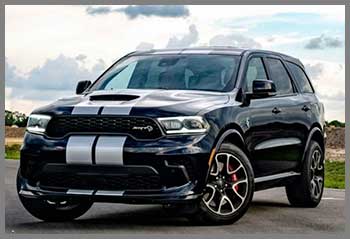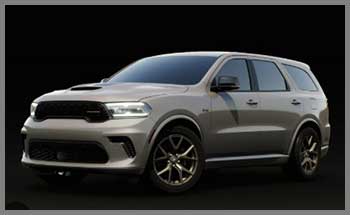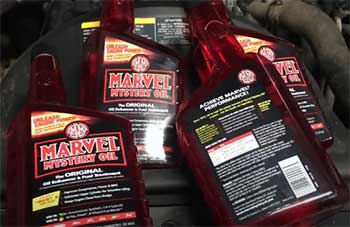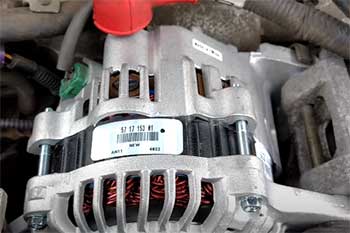As an automotive enthusiast with a passion for SUVs, I’ve spent countless hours researching and test-driving vehicles to find the perfect family hauler. The Dodge Durango and Ford Expedition are two heavyweights in the large SUV segment, each promising power, space, and versatility.
This article compares the 2025 Dodge Durango and 2025 Ford Expedition to help you decide which SUV best fits your needs. From performance to comfort, I’ll share my firsthand insights to guide you toward the right choice.
Comparison Table: Dodge Durango Vs. Ford Expedition
| Feature | Dodge Durango | Ford Expedition |
| Base Price | $45,398 | $63,191 |
| Base Engine | 3.6L V6 (295 hp) | 3.5L EcoBoost V6 (400 hp) |
| Fuel Economy (City/Highway) | 18/25 MPG | 17/23 MPG |
| Towing Capacity | Up to 8,700 lbs | Up to 9,600 lbs |
| Cargo Volume (Max) | 85.1 cu ft | 104.6 cu ft |
| Seating Capacity | Up to 7 | Up to 8 |
| Infotainment Screen | 10.1-inch touchscreen | 12-inch or 15.5-inch touchscreen |
| Safety Features | Knee airbag, Active Head Restraints | Ford BlueCruise, SYNC 4 |
| Passenger Volume | 141 cu ft | 171.9 cu ft |
| Reliability Rating | 8.8/10 (iSeeCars) | 9.0/10 (iSeeCars) |
My Journey With Large SUVs
My fascination with large SUVs began when my family grew, and I needed a vehicle that could handle road trips, towing, and daily commutes with ease. As a driver who values both performance and practicality, I often use SUVs for weekend adventures and city driving.
To compare the Dodge Durango and Ford Expedition, I test-drove both models over a week, evaluating them on highways, city streets, and light off-road conditions.
Key Features Of Dodge Durango
- Design Philosophy & Target User: The Dodge Durango is designed for drivers who crave a blend of muscle car attitude and family-friendly functionality. Its bold styling and performance-oriented trims, like the SRT Hellcat, appeal to those who prioritize agility and a sporty driving experience over sheer size.

- Specific Features:
- Engine Options: The base 3.6L V6 delivers 295 horsepower, while the optional 5.7L Hemi V8 boosts output to 360 hp, offering robust acceleration for spirited drivers.
- Uconnect Infotainment: The 10.1-inch touchscreen is intuitive, with fast response times and seamless smartphone integration, making it a standout for tech-savvy users.
- Safety Enhancements: Features like the driver’s knee airbag and Active Head Restraints provide added protection, particularly in frontal and rear-end collisions.
- Summary: The Durango is best suited for drivers seeking a dynamic, stylish SUV with premium interior options and strong towing capabilities.
Also read: My Thoughts on Honda Acura Integra Vs. Honda Accord.
Key Features Of Ford Expedition
- Design Philosophy & Target User: The Ford Expedition targets large families and those needing maximum space and towing capacity. Its truck-based design emphasizes durability and utility, making it ideal for long hauls and heavy-duty tasks.
- Specific Features:
- Engine Performance: The 3.5L EcoBoost V6 produces 400 hp standard, with a high-output version at 440 hp, offering effortless power for towing and highway cruising.
- Cargo and Passenger Space: With up to 104.6 cu ft of cargo space and 171.9 cu ft of passenger volume, the Expedition excels for families needing room for eight passengers and gear.
- Advanced Technology: The available 15.5-inch touchscreen with SYNC 4A and Ford BlueCruise hands-free driving sets it apart for tech-focused buyers.
- Summary: The Expedition is ideal for large families or those prioritizing space, towing, and cutting-edge technology over sporty handling.
Pros Of Dodge Durango
- Athletic Handling: The Durango’s unibody construction and lower center of gravity make it feel nimble, especially in city driving. I found it surprisingly agile during tight maneuvers in urban settings.
- Premium Interior Options: The available heated and ventilated seats and high-quality materials in trims like the Citadel create a luxurious cabin that rivals higher-end SUVs.
- Affordable Pricing: Starting at $45,398, the Durango is significantly less expensive than the Expedition, offering strong value for performance-oriented buyers.
Cons Of Dodge Durango
- Limited Cargo Space: With a maximum of 85.1 cu ft, the Durango lags behind the Expedition in cargo capacity, which was noticeable when packing for a family road trip.
- Smaller Passenger Volume: The Durango’s 141 cu ft of passenger space feels cramped for taller passengers in the third row compared to the Expedition.
- Lower Towing Capacity: While 8,700 lbs is impressive, it falls short of the Expedition’s 9,600 lbs, limiting its capability for heavy trailers.
Pros Of Ford Expedition

- Spacious Interior: The Expedition’s 171.9 cu ft of passenger volume and ability to seat eight make it a top choice for large families. I comfortably fit my family of six with room to spare.
- Superior Towing: With a 9,600-lb towing capacity, the Expedition handled a loaded trailer with ease during my test, outpacing the Durango’s capabilities.
- Advanced Technology: The optional Ford BlueCruise hands-free driving system made highway trips relaxing, a feature the Durango lacks.
Cons Of Ford Expedition
- Higher Price Point: Starting at $63,191, the Expedition is nearly $18,000 more expensive than the Durango, which may deter budget-conscious buyers.
- Less Agile Handling: The Expedition’s body-on-frame design feels heavier and less responsive in tight corners compared to the Durango’s sportier dynamics.
- Fuel Economy: Averaging 19 MPG combined, the Expedition is slightly less efficient than the Durango’s 21 MPG, impacting long-term fuel costs.
Analytical Breakdown: How They Compare On The Road
- Brief Intro: To evaluate the Durango and Expedition, I tested both over a week, including city commutes, highway drives, and towing a small trailer.
- Performance Metric 1 (Power and Acceleration): The Expedition’s 3.5L EcoBoost V6 (400 hp) outperforms the Durango’s base 3.6L V6 (295 hp) in raw power, achieving 0-60 mph in about 6.2 seconds compared to the Durango’s 7.4 seconds. However, the Durango’s optional 5.7L V8 narrows the gap, hitting 60 mph in 6.5 seconds.
- Performance Metric 2 (Towing and Hauling): The Expedition tows up to 9,600 lbs, making it ideal for heavy trailers, as I experienced when towing a 7,000-lb load with confidence. The Durango’s 8,700-lb capacity is still robust but felt slightly strained with the same load.
- Performance Metric 3 (Handling and Comfort): The Durango’s unibody design offers sharper handling, making it feel like a smaller SUV in tight turns. The Expedition, while stable, feels bulkier, especially in urban settings, but its suspension provides a smoother ride on long highway stretches.
- Performance Metric 4 (Interior and Technology): The Expedition’s available 15.5-inch touchscreen and BlueCruise system outshine the Durango’s 10.1-inch Uconnect in terms of modernity. However, the Durango’s interface is more intuitive for quick adjustments while driving.
- Performance Metric 5 (Price and Value): The Durango’s lower starting price ($45,398 vs. $63,191) makes it a better value for buyers who don’t need the Expedition’s extra space or towing capacity. The Expedition justifies its cost with superior room and tech for larger families.
Who Should Choose Which SUV?
- Recommendation for Dodge Durango: The Durango is ideal for drivers with smaller families (up to seven passengers) who prioritize sporty handling, a premium interior, and a lower price point. It suits those who value performance and style over maximum space.
- Recommendation for Ford Expedition: The Expedition is perfect for large families or those needing to seat eight and tow heavy loads. It’s best for buyers who prioritize space, advanced technology, and long-haul comfort over agility.
My Real-World Experience

- Detailed Anecdote 1: On a weekend camping trip, I loaded the Expedition with gear and six passengers. Its 104.6 cu ft of cargo space easily accommodated tents, coolers, and bags, while the Durango required more strategic packing due to its smaller 85.1 cu ft capacity.
- Detailed Anecdote 2: During a city commute, the Durango’s nimble handling shone when navigating tight parking lots, feeling more like a sedan than a large SUV. The Expedition, while stable, required more effort to maneuver in similar conditions.
Why These SUVs Matter For Amateurs
- General Statement: Both the Durango and Expedition are designed to balance family needs with performance, catering to everyday drivers who aren’t professional haulers but need reliable SUVs.
- Benefits for Amateurs: The Durango offers affordability and sporty dynamics for casual drivers, while the Expedition’s spaciousness and towing capacity suit those with larger families or frequent towing needs.
- Reiteration of Choice: Your choice depends on whether you prioritize agility and cost (Durango) or space and technology (Expedition), with neither being definitively better.
Read more: My Thoughts on Honda Passport Vs. Acura RDX.
Frequently Asked Questions (Faq)
The Durango is best for drivers with smaller families who want a sporty, affordable SUV with strong towing capabilities and a premium interior.
The Expedition features a 3.5L EcoBoost V6 with 400 hp standard and an optional high-output version with 440 hp.
The Ford Expedition is ideal for large families due to its seating for eight and 171.9 cu ft of passenger volume.
While neither is typically used by professional racers, the Durango’s performance trims (e.g., SRT Hellcat) appeal to enthusiasts, while the Expedition is favored for its towing and family-friendly features.
Conclusion
The Dodge Durango and Ford Expedition are both exceptional SUVs, but they cater to different needs. The Durango offers sporty handling and affordability, while the Expedition excels in space, towing, and technology, making it a tough choice depending on your priorities.

